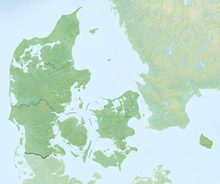Ølshøj
Coordinates: 56 ° 6 ′ 7 " N , 12 ° 13 ′ 45.1" E
The Ølshøj , (also called Olshøj or Ullershøj) is a small double passage grave of the funnel cup culture (TBK) from the middle Neolithic (3500–2800 BC) It is located between Blistrup and Smidstrup in the far north of the island of Zealand in Denmark . There are around 60 double-passage graves in Denmark and Sweden (3), the main area of which is the island of Zealand. The two passage graves share a common partition. Usually the axes of the chambers form an obtuse angle and, with their long corridors, adapt to the round hills. The klekkende høj is the only example of a chamber conditioning, all of whose axes form straight lines at right angles.
The passage grave is a form of Neolithic megalithic systems , which consists of a chamber and a structurally separated, lateral passage. This form is primarily found in Denmark, Germany and Scandinavia, as well as occasionally in France and the Netherlands. Neolithic monuments are an expression of the culture and ideology of Neolithic societies. Their origin and function are considered to be the hallmarks of social development.
description
The southern chamber has an oval floor plan and is about 4.0 m long and 2.5 m wide. It consists of two preserved cover stones and nine bearing stones, between which there is dry masonry . The floor of the chamber is covered with stone slabs. The west-east oriented 5.5 m long corridor opens in the middle of the chamber. It is 0.8 m wide, 1.2 m high and made of 11 preserved bearing stones, between which dry masonry has been preserved. Door stones are installed opposite each other in the corridor, 1.5 m from the outside.
The north chamber has an oval floor plan and is about 3.6 m long and 2.1 m wide. It consists of a preserved cover stone and eight bearing stones. The floor is covered with stone slabs. The west-east oriented 3.1 m long corridor is 1.4 m wide and 1.2 m high and opens in the middle of the chamber. Its floor is covered with stone slabs.
The finds, unearthed in 1855 and 1960, consist of an ax (of the Lindø type), a thick-nosed ax (type B), a dagger (type I), amber beads and some inconspicuous clay pots.
In the hill, built in secondary, was a stone box without a capstone in which a dagger (type III B) was found.
See also
literature
- Torbjørn Ølshøj Jensen, Thomas Kvist, Marie Just Mikkelsen, Peter Vittrup Christensen, Peter Westermann: Fermentation of crude glycerol from biodiesel production by Clostridium pasteurianum . In: Journal of industrial microbiology & biotechnology . tape 39 , no. 5 . Springer, 2012, p. 709-717 .
- Karsten Kjer Michaelsen: Politikens bog om Danmarks oldtid (= Politikens håndbøger. ). Politiken, Copenhagen 2002, ISBN 87-567-6458-8 .
Individual evidence
- ^ Johannes Müller : Neolithic Monuments and Neolithic Societies. In: Hans-Jürgen Beier , Erich Claßen, Thomas Doppler, Britta Ramminger (eds.): Varia neolithica VI. Neolithic Monuments and Neolithic Societies. Contributions from the meeting of the Neolithic Working Group during the annual meeting of the North-West German Association for Ancient Research in Schleswig, 9. – 10. October 2007 (= contributions to the prehistory and early history of Central Europe. Vol. 56). Beier & Beran, Langenweißbach 2009, ISBN 978-3-941171-28-2 , pp. 7-16, here p. 15.

